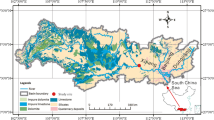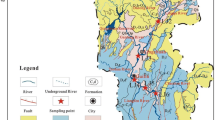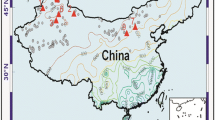Abstract
Biological carbon pumping (BCP) is a key process in which dissolved inorganic carbon in terrestrial aquatic ecosystems is utilized by aquatic autotrophs for photosynthesis and transformed into autochthonous organic matter (AOC). However, the mechanisms underlying BCP and the amount of generated AOC deposited effectively, are still poorly understood. Therefore, we conducted a systematic study combining modern hydrochemical monitoring and a sediment trap experiment in Fuxian Lake (Yunnan, SW China), the second-deepest plateau, oligotrophic freshwater lake in China. Temperature, pH, EC (electrical conductivity), DO (dissolved O2), [HCO3−], [Ca2+], SIc, partial CO2 (pCO2) pressure, and carbon isotopic compositions of HCO3− (δ13CDIC) in water from Fuxian Lake all displayed distinct seasonal and vertical variations. This was especially apparent in an inverse correlation between pCO2 and DO, indicating that variations of hydrochemistry in the lake water were mainly controlled by the metabolism of the aquatic phototrophs. Furthermore, the lowest C/N ratios and highest δ13Corg were recorded in the trap sediments. Analyses of the C/N ratio demonstrated that the proportions of AOC ranged from 30% to 100% of all OC, indicating that AOC was an important contributor to sedimentary organic matter (OC). It was calculated that the AOC flux in Fuxian Lake was 20.43 t C km−2 in 2017. Therefore, AOC produced by carbonate weathering and aquatic photosynthesis could potentially be a significant carbon sink and may have an important contribution to solving the lack of carbon sinks in the global carbon cycle.









Similar content being viewed by others
References
Brenner M, Whitmore TJ, Curtis JH, Hodell DA, Schelske CL (1999) Stable isotope (δ13C and δ15N) signatures of sedimented organic matter as indicators of historic lake trophic state. J Paleolimnol 22(2):205–221
Broecker WS, Takahashi T, Simpson HJ, Peng TH (1979) Fate of fossil fuel carbon dioxide and the global carbon budget. Science 206(4417):409–418
Brothers S, Vermaire JC, Gregory-Eaves I (2008) Empirical models for describing recent sedimentation rates in lakes distributed across broad spatial scales. J Paleolimnol 40(4):1003–1019
Chen B, Yang R, Liu ZH, Sun HL, Yan H, Zeng QR, Zeng SB, Zeng C, Zhao M (2017) Coupled control of land uses and aquatic biological processes on the diurnal hydrochemical variations in the five ponds at the Shawan Karst Test Site, China: implications for the carbonate weathering-related carbon sink. Chem Geol 456:58–71
Chen JA, Yang HQ, Zeng Y, Guo JY, Song YL, Ding W (2018) Combined use of radiocarbon and stable carbon isotope to constrain the sources and cycling of particulate organic carbon in a large freshwater lake, China. Sci Total Environ 625:27–38
Ciais P et al (2013) Carbon and other biogeochemical cycles. In: Stocker TF (ed) Climate Change 2013: The physical science basis. Contribution of working group I to the fifth assessment report of the intergovernmental panel on climate change. Cambridge University Press, Cambridge, pp 465–570
Cole JJ, Caraco NF, Kling GW, Kratz TK (1994) Carbon dioxide supersaturation in the surface waters of lakes. Science 265(5178):1568–1570
Cole JJ, Prairie YT, Caraco NF, McDowell WH, Tranvik LJ, Striegl RG, Melack J (2007) Plumbing the global carbon cycle: integrating inland waters into the terrestrial carbon budget. Ecosystems 10(1):172–185
Cui GY, Li XD, Li QK, Huang J, Tao YL, Li SQ, Zhang J (2017) Damming effects on dissolved inorganic carbon in different kinds of reservoirs in Jialing River, Southwest China. Acta Geochim 36(4):581–597
Ding W, Chen JA, Yang HQ, Tao HB, Luo J (2016) Investigation on sources of organic carbon in major rivers in the catchment of Fuxian Lake, Yunnan Province. Earth Environ 44(3):290–296
Falkowski PG, Raven JA (1997) Aquatic photosynthesis. Blackwell Science, Oxford
Galy V, Eglinton T, France-Lanord C, Sylva S (2011) The provenance of vegetation and environmental signatures encoded in vascular plant biomarkers carried by the Ganges–Brahmaputra rivers. Earth Planet Sci Lett 304(1–2):1–12
Goñi MA, Teixeira MJ, Perkey DW (2003) Sources and distribution of organic matter in a river-dominated estuary (Winyah Bay, SC, USA). Estuar Coast Shelf Sci 57(5–6):1023–1048
Gudasz C, Bastviken D, Steger K, Premke K, Sobek S, Tranvik LJ (2010) Temperature-controlled organic carbon mineralization in lake sediments. Nature 466(7305):478
Han GL, Tang Y, Wu QX (2010) Hydrogeochemistry and dissolved inorganic carbon isotopic composition on karst groundwater in Maolan, Southwest China. Environ Earth Sci 60(4):893–899
Hollander DJ, McKenzie JA (1991) CO2 control on carbon-isotope fractionation during aqueous photosynthesis: a paleo-pCO2 barometer. Geology 19(9):929–932
Huang CC, Yao L, Zhang YL, Huang T, Zhang ML, Zhu AX, Yang H (2017) Spatial and temporal variation in autochthonous and allochthonous contributors to increased organic carbon and nitrogen burial in a plateau lake. Sci Total Environ 603:390–400
Kelts K, Hsü KJ (1978) Freshwater carbonate sedimentation. In: Lakes. Springer, New York, pp 295–323
Lamb HF, Leng MJ, Telford RJ, Ayenew T, Umer M (2007) Oxygen and carbon isotope composition of authigenic carbonate from an Ethiopian lake: a climate record of the last 2000 years. Holocene 17(4):517–526
Lewis WM Jr (2011) Global primary production of lakes: 19th Baldi Memorial Lecture. Inland Waters 1(1):1–28
Li SL, Liu CQ, Lang YC, Tao F, Zhao ZQ, Zhou ZH (2008) Stable carbon isotope biogeochemistry and anthropogenic impacts on karst ground water, Zunyi, Southwest China. Aquat Geochem 14(3):211
Liang H, Huang LP, Chen GJ, Kang WG, Liu YY, Wang JY, Zhu QS, Liu S, Deng Y (2018) Patterns of carbon and nitrogen stable isotopes and elemental composition of lake primary producers and zooplankton in Eastern Yunnan. J Lake Sci 30(5):1400–1412
Liu ZH, Dreybrod W (1997) Dissolution kinetics of calcium carbonate minerals in H2O–CO2 solutions in turbulent flow: the role of the diffusion boundary layer and the slow reaction H2O + CO2 → H++ HCO3 −. Geochim Cosmochim Acta 61(14):2879–2889
Liu Y, Wu G, Gao ZW (2008) Impacts of land-use change in Fuxian and Qilu basins of Yunnan Province on lake water quality. Chin J Ecol 27(3):447–453
Liu ZH, Dreybrodt W, Wang HJ (2010) A new direction in effective accounting for the atmospheric CO2 budget: considering the combined action of carbonate dissolution, the global water cycle and photosynthetic uptake of DIC by aquatic organisms. Earth Sci Rev 99(3–4):162–172
Liu ZH, Dreybrodt W, Liu H (2011) Atmospheric CO2 sink: silicate weathering or carbonate weathering? Appl Geochem 26:S292–S294
Liu ZH, Macpherson GL, Groves C, Martin JB, Yuan DX, Zeng SB (2018) Large and active CO2 uptake by coupled carbonate weathering. Earth Sci Rev 182:42–49
McKenzie JA (1985) Carbon isotopes and productivity in the lacustrine and marine environment. In: Stumm W (ed) Chemical processes in lakes. Wiley, New York, pp 99–118
Melnikov NB, O’Neill BC (2006) Learning about the carbon cycle from global budget data. Geophys Res Lett 33(2)
Meyer KM, Yu M, Lehrmann D, Van de Schootbrugge B, Payne JL (2013) Constraints on early triassic carbon cycle dynamics from paired organic and inorganic carbon isotope records. Earth Planet Sci Lett 361:429–435
Meyers PA (1997) Organic geochemical proxies of paleoceanographic, paleolimnologic, and paleoclimatic processes. Org Geochem 27(5–6):213–250
Meyers PA (2003) Applications of organic geochemistry to paleolimnological reconstructions: a summary of examples from the Laurentian Great Lakes. Org Geochem 34(2):261–289
Meyers PA, Ishiwatari R (1993) Lacustrine organic geochemistry: an overview of indicators of organic matter sources and diagenesis in lake sediments. Org Geochem 20(7):867–900
O’Reilly SS, Szpak MT, Flanagan PV, Monteys X, Murphy BT, Jordan SF, Kelleher BP (2014) Biomarkers reveal the effects of hydrography on the sources and fate of marine and terrestrial organic matter in the western Irish Sea. Estuar Coast Shelf Sci 136:157–171
Parker SR, Gammons CH, Poulson SR, DeGrandpre MD, Weyer CL, Smith MG, Oba Y (2010) Diel behavior of stable isotopes of dissolved oxygen and dissolved inorganic carbon in rivers over a range of trophic conditions, and in a mesocosm experiment. Chem Geol 269(1–2):22–32
Parkhurst DL, Appelo CAJ (1999) User’s guide to PHREEQC (version 2): a computer program for speciation, batch-reaction, one-dimensional transport, and inverse geochemical calculations. In: US Geological Survey Water Resources Investigations Report, pp 99–4259
Passow U, Carlson CA (2012) The biological pump in a high CO2 world. Mar Ecol Prog Ser 470:249–271
Ramaswamy V, Gaye B, Shirodkar PV, Rao PS, Chivas AR, Wheeler D, Thwin S (2008) Distribution and sources of organic carbon, nitrogen and their isotopic signatures in sediments from the Ayeyarwady (Irrawaddy) continental shelf, northern Andaman Sea. Mar Chem 111(3–4):137–150
Redfield AC (1963) The influence of organisms on the composition of seawater. Sea 2:26–77
Schindler DW (1999) Carbon cycling: the mysterious missing sink. Nature 398(6723):105
Sobek S, Tranvik LJ, Cole JJ (2005) Temperature independence of carbon dioxide supersaturation in global lakes. Glob Biogeochem Cycles 19(2)
Sobek S, Anderson NJ, Bernasconi SM, Del Sontro T (2014) Low organic carbon burial efficiency in arctic lake sediments. J Geophys Res: Biogeosci 119(6):1231–1243
Sun HG, Han JT, Zhang SR, Lu XX (2011) Transformation of dissolved inorganic carbon (DIC) into particulate organic carbon (POC) in the lower Xijiang River, SE China: an isotopic approach. Biogeosci Discus 8(5):9471–9501
Sundquist ET (1993) The global carbon dioxide budget. Science 934–941
Tue NT, Hamaoka H, Sogabe A, Quy TD, Nhuan MT, Omori K (2011) The application of δ13C and C/N ratios as indicators of organic carbon sources and paleoenvironmental change of the mangrove ecosystem from Ba Lat Estuary, Red River, Vietnam. Environ Earth Sci 64(5):1475–1486
Usbeck R, Schlitzer R, Fischer G, Wefer G (2003) Particle fluxes in the ocean: comparison of sediment trap data with results from inverse modeling. J Mar Syst 39(3–4):167–183
Valero-Garcés BL, Delgado-Huertas A, Ratto N, Navas A (1999) Large 13C enrichment in primary carbonates from Andean Altiplano lakes, northwest Argentina. Earth Planet Sci Lett 171(2):253–266
Wachniew P, Różański K (1997) Carbon budget of a mid-latitude, groundwater-controlled lake: isotopic evidence for the importance of dissolved inorganic carbon recycling. Geochim Cosmochim Acta 61(12):2453–2465
Wang SM, Dou HS (1998) China lakes chorography. Science Press, Beijing
Waterson EJ, Canuel EA (2008) Sources of sedimentary organic matter in the Mississippi River and adjacent Gulf of Mexico as revealed by lipid biomarker and δ13CTOC analyses. Org Geochem 39(4):422–439
Xiao HY (2017) Effects and underlying mechanisms of damming on carbon and nitrogen cycles and transport in rivers of southwest China: project introduction. Acta Geochim 36(4):577–580
Xu H, Ai L, Tan LC, An ZS (2006) Stable isotopes in bulk carbonates and organic matter in recent sediments of Lake Qinghai and their climatic implications. Chem Geol 235(3–4):262–275
Yao B, Liu QQ, Hu CM, Xi BD, Wu XH (2017) Distribution characteristics of phosphorus in the water of Lake Fuxian and its influencing factors. Sci Technol Rev 35(3):66–71
Acknowledgements
This work was supported by the National Natural Science Foundation of China (Nos. 41430753, U1612441).
Author information
Authors and Affiliations
Corresponding author
Rights and permissions
About this article
Cite this article
He, H., Liu, Z., Chen, C. et al. Influence of the biological carbon pump effect on the sources and deposition of organic matter in Fuxian Lake, a deep oligotrophic lake in southwest China. Acta Geochim 38, 613–626 (2019). https://doi.org/10.1007/s11631-019-00359-5
Received:
Revised:
Accepted:
Published:
Issue Date:
DOI: https://doi.org/10.1007/s11631-019-00359-5




